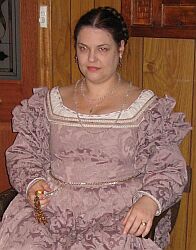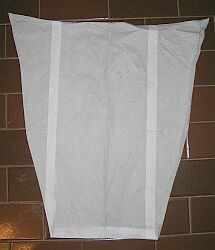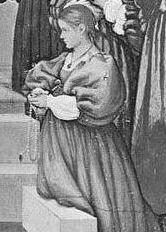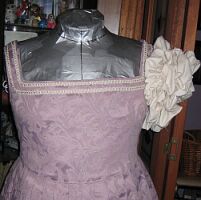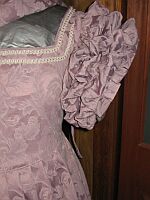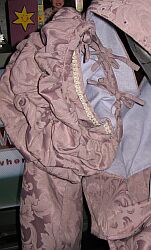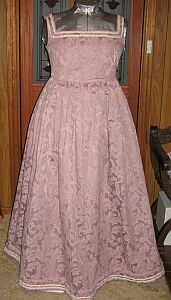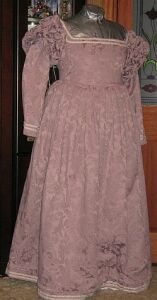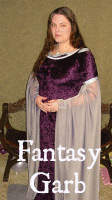Recreated by La Signora Onorata Katerina da Brescia.
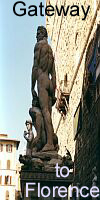 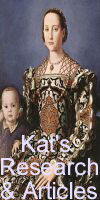  |
Sottana:
appears to be influenced by the
current fashions of the area and by the 'official' fashions adopted by
Eleanora di Toledo. This sottana is of a paler colour
Styles: The following are portraits of sottana from 1540s Florence. 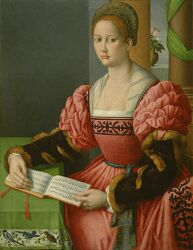 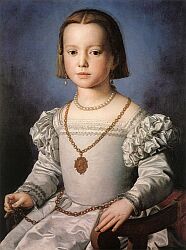 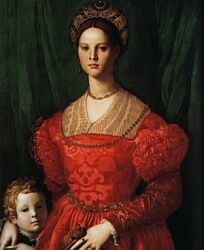 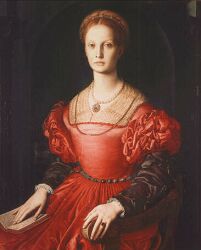 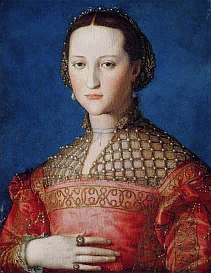
1. Bacchiacca's Portrait of a Woman with a Book of Music, 2.Bronzino's Bia, The Illegitimate Daughter of Cosimo I de' Medici 1542. 3. Bronzino 1545-46. portrait 4.Bronzino's Portrait of Lucrezia Panciatichi, 1540. (Uffuzi). 5. Bronzino's Eleanora di Toledo, 1543.
Some similarities and some differences can be seen. This is possibly due to the differing social stature, with the more affluent wearing the more current fashions. Bia's sottana is influenced by the general fashions, but also by the fashions worn by her mother, Eleanora di Toledo. (5). So it seems that there was a reasonable variation of fashions, possibly local and influenced by Eleanora's fashions (?) Below is based on portraits 1-4, with the fifth to compare to Eleanora's 'official' fashion which became more fashionable in the 1550's.
Pattern: I adapted the pattern from the extant burial dress of
Eleanora d' Toledo from Janet
Arnold's Pattern of Fashion, and the Red Pisa Sottana discussed in L'Abito della Granduchessa; Vesti di corte di Madonne nel Palazzo Reale di Pisa.(seen in the section on sleeves). I adapted the imbusto and waistline for a decade or two earlier. There were no available extant sleeves for the burial gown, so
I based the sleeve pattern from L'Abito della Granduchessa.
not unheard of. La Moda a Fiorenze also states that sottana could be worn at home without sleeves. Eleanora's guardaroba also specifically lists sottana senza maniche - dresses without sleeves. This suggests that the sottana was actually ordered, or at least listed withougt the sleeves.
For the upper part of the sleeve, I used a base sleeve with a gathered (larger about 3x sleeve) on the outside. Below are pics of the sleeve in progress. Left is the baragoni pattern for the 'base sleeve'. The gathered top was increased by 3x in size and gathered (far left). Tabs were put on the bottom of the baragoni, as seen in Bia's portrait (seen in second pic).This can be worn without the under sleeve, for summer. The under sleeve was clipped at the cuff, also to match the portrait. The third picture shows the undersleeve tied in. The baragoni was handsewn in at the top. Below right is the final sleeve - both baragoni and undersleeve.
Decoration:
decoration on the sottana. Far right is the finished sleeve. Bibliography:
Web Sites: Medici Archive Project: www.medici.org/ (1/06) Web Gallery: Medici portraits by Bronzino. http://www.kfki.hu/~/arthp/html/b/bronzino/1/index.html Archeological Sewing by Heather Rose Jones (2001) http://heatherrosejones.com/archaeologicalsewing/index.html (new adsottana: 8/06) Sewing Stitches Used in Medieval Clothing: http://www.personal.utulsa.edu/~marc-carlson/cloth/stitches.htm Archive of Stitches from Extant Textiles. www.bayrose.org (c) K Carlisle. Feb, 2007
|
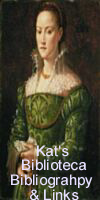   |
All intellectual content, photos and layout are copyright to La Signora Onorata Katerina da Brescia (K Carlisle), except those original renaissance artworks and extant articles whose copyright remains with the current owner.
If
you would like to use something from this site, please
contact me, and cite this website reference.
(c). K.Carlisle, 2009.

